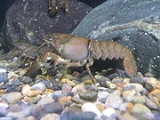
Pacifastacus
Encyclopedia
Pacifastacus is a genus
of crayfish
native to western North America
, containing the following six species (DD = Data Deficient
; CR = Critically Endangered
; LC = Least Concern
; EX = Extinct
):
Genus
In biology, a genus is a low-level taxonomic rank used in the biological classification of living and fossil organisms, which is an example of definition by genus and differentia...
of crayfish
Crayfish
Crayfish, crawfish, or crawdads – members of the superfamilies Astacoidea and Parastacoidea – are freshwater crustaceans resembling small lobsters, to which they are related...
native to western North America
North America
North America is a continent wholly within the Northern Hemisphere and almost wholly within the Western Hemisphere. It is also considered a northern subcontinent of the Americas...
, containing the following six species (DD = Data Deficient
Data Deficient
Data Deficient is a category applied by the IUCN, other agencies, and individuals to a species when the available information is not sufficient for a proper assessment of conservation status to be made...
; CR = Critically Endangered
Critically Endangered
Critically Endangered is the highest risk category assigned by the IUCN Red List for wild species. Critically Endangered means that a species' numbers have decreased, or will decrease, by 80% within three generations....
; LC = Least Concern
Least Concern
Least Concern is an IUCN category assigned to extant taxon or lower taxa which have been evaluated but do not qualify for any other category. As such they do not qualify as threatened, Near Threatened, or Conservation Dependent...
; EX = Extinct
Extinction
In biology and ecology, extinction is the end of an organism or of a group of organisms , normally a species. The moment of extinction is generally considered to be the death of the last individual of the species, although the capacity to breed and recover may have been lost before this point...
):
- Pacifastacus chenoderma (fossil: MioceneMioceneThe Miocene is a geological epoch of the Neogene Period and extends from about . The Miocene was named by Sir Charles Lyell. Its name comes from the Greek words and and means "less recent" because it has 18% fewer modern sea invertebrates than the Pliocene. The Miocene follows the Oligocene...
– PliocenePlioceneThe Pliocene Epoch is the period in the geologic timescale that extends from 5.332 million to 2.588 million years before present. It is the second and youngest epoch of the Neogene Period in the Cenozoic Era. The Pliocene follows the Miocene Epoch and is followed by the Pleistocene Epoch...
) - Pacifastacus connectens
- Pacifastacus fortisShasta crayfishPacifastacus fortis is an endangered crayfish species endemic to Shasta County, California, where it is found only in isolated spots on the Pit River and Fall River Mills....
– shasta crayfish - Pacifastacus gambelii
- Pacifastacus leniusculusSignal crayfishThe signal crayfish, Pacifastacus leniusculus, is a North American species of crayfish. It was introduced to Europe in the 1960s to supplement the Scandinavian Astacus astacus fisheries, which were being damaged by crayfish plague, but the imports turned out to be a carrier of that disease...
– signal crayfish - Pacifastacus nigrescensPacifastacus nigrescensPacifastacus nigrescens, the sooty crayfish, was a species of crayfish in the family Astacidae. It was originally described in 1857 by William Stimpson from the area around San Francisco, where it was once common in the creeks surrounding San Francisco Bay...

